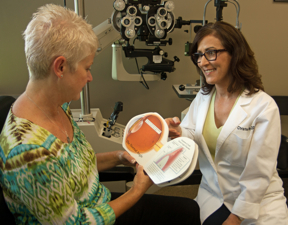Low Vision and Vision Loss
What can a person with low vision really see? That question is not an easy one to answer because every person with a visual impairment truly has a unique pattern of vision loss. No two people have the same exact vision loss!
Macular degeneration, glaucoma, diabetic retinopathy, and congenital eye disease, among the hundreds of other conditions that can cause us to lose some of our vision, all result in slightly different ways for a person to see.
Some eye diseases cause us to lose our central vision fibers, creating a sort of ‘Swiss cheese’ pattern of blindspots. People experience this type of sight loss as things looking dim, wavy, distorted, blurry, or irregular. When our central retinal vision is damaged, it’s hard to see faces and small details, or even to read printed words like mail, street signs, and TV captions.
Other eye problems, like retinal detachment and glaucoma can affect our side vision, or peripheral vision. Blind spots in our peripheral vision make getting around more difficult. People with loss of side vision, like after a brain stroke or serious head trauma, are more likely to trip over things, loose balance, feel disorientated, and have more confusion with regards to motion in their environment.
Vision is our primary and most important sense, so losing any vision can be frightening. Knowing how our amazing eyes work and how we actually see and what can be done, can reduce the stress of vision loss. Acceptance, understanding and moving forward allows benefits from low vision rehabilitation.
Here’s a very brief overview of our basic vision function: each of our eyes has over one million vision fibers coming down from the brain, which when bundled together are called the optic nerve. Those nerve fibers spread out and line the inside of the eye to form a thin film of nervous system tissue that we call the retina. The retina is responsible for “catching” everything that our eyes look at, and then our retinas send that captured information back to the brain for processing, learning, and storing.

The good news here is that something can be done to help a person with loss of vision see better. Low vision specialists, like Dr. Christina Petrou, work with your ophthalmologist, retina surgeon, and other eye doctors. The role of a low vision optometrist is not to replace your primary eye doctor, but to help identify where and how a person sees their best, and to maximize that vision.
At Petrou Eye Care, a low vision examination and consultation allows time to create a plan of educating, training, and bringing awareness to new ways of improving the function of a person’s remaining vision. Initial low vision consultations can last up to 3 hours, and may be spread over multiple office visits. Contrast enhancement, magnification and lighting evaluation, blind spot mapping, and many other vision function tests are introduced for each person’s unique vision loss and daily life skill requirements.
If you know someone who would benefit from low vision rehab, have him or her call Dr. Christina Petrou at 414-247-2020. She and her team of low vision professionals are available by appointment to guide and offer resources for patients needing help in the metro Milwaukee area.




